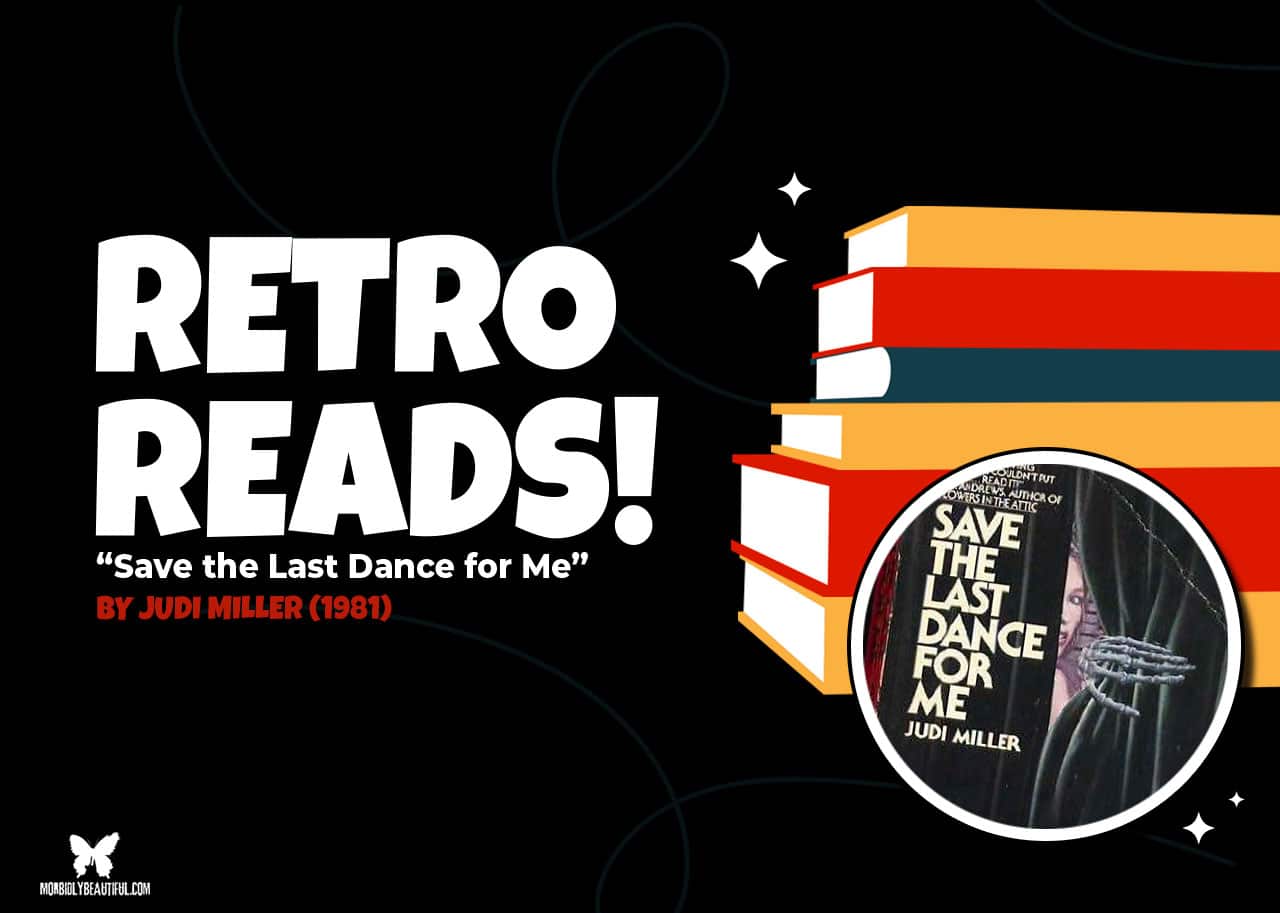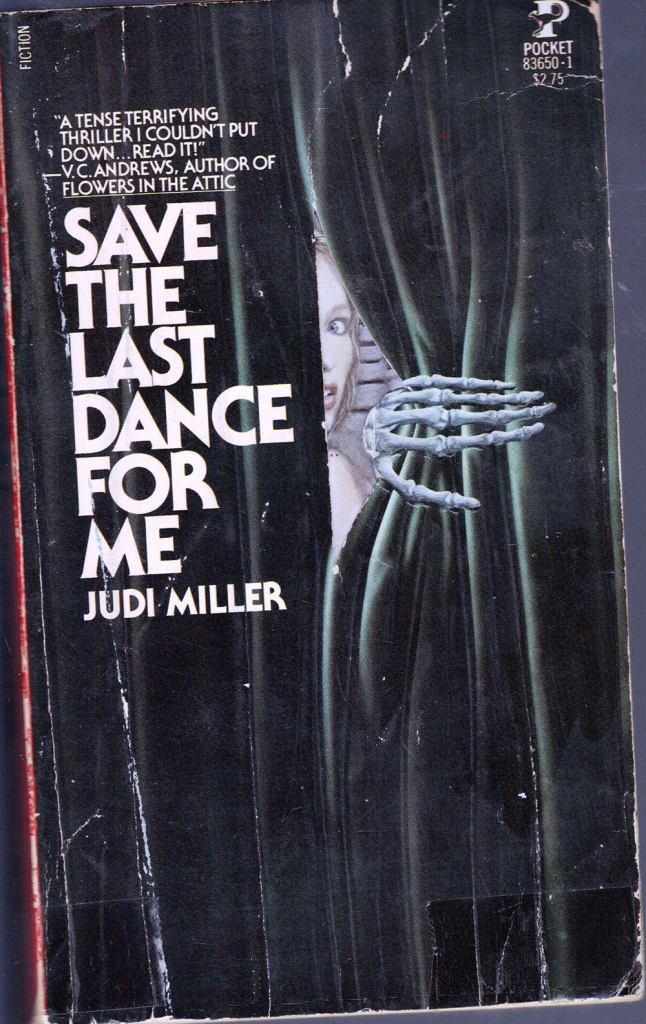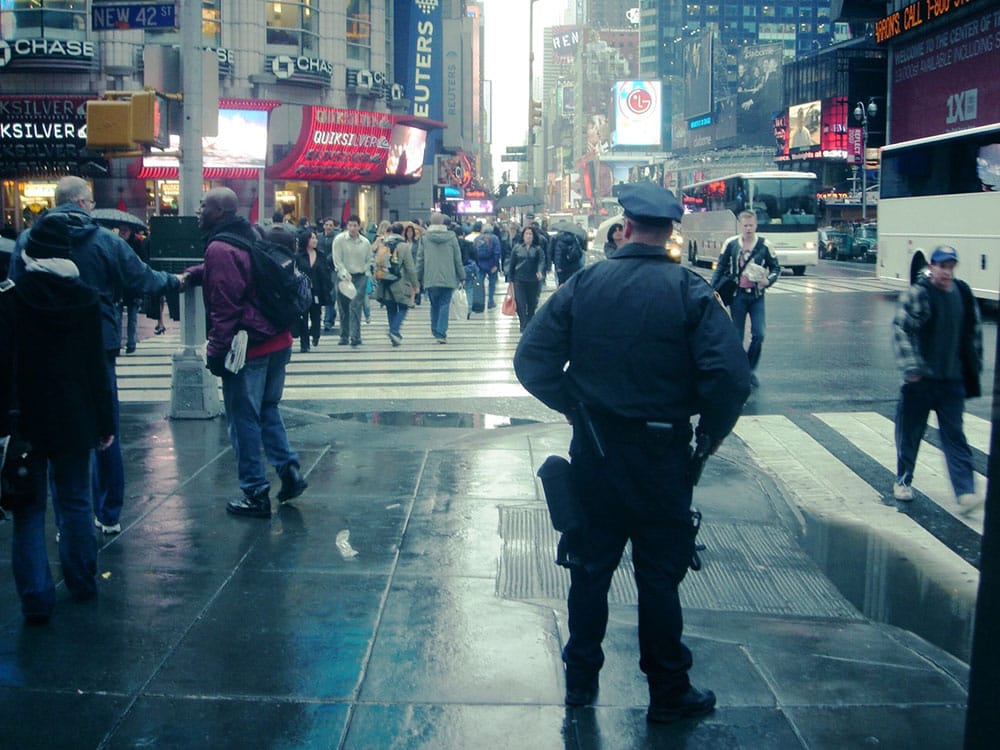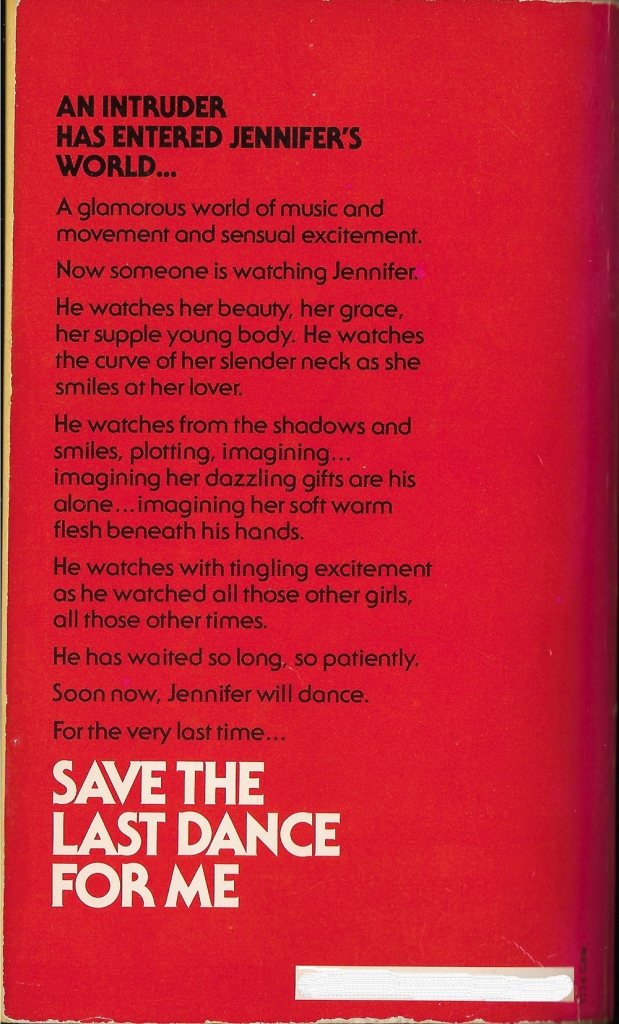“Save the Last Dance for Me” is a soapy serial killer thriller set in the glamorous, competitive, and deadly world of…ballet. Seriously.
Well now, wasn’t that one hell of a blast from the past?!
Given that I didn’t start seriously reading scary books until roughly 1988, I generally missed out on a lot of these paperback “classics”. King and Koontz were the big draw authors at the time, and I got fully ensnared by their offerings, along with various and sundry fantasy, science fiction, and action novels. Of course, I was also very young and didn’t have a job yet. So I was beholden to whatever my mom was willing to buy for me.
Funny how all these years later my basic book tastes really haven’t changed. Sure, I’ve added a few more genres to the reading repertoire. But when in doubt, I always default back to my fabulous foursome (fantasy, sci-fi, horror, and action).
ABOUT THE BOOK
Save The Last Dance For Me (STLDFM from here on out) was released by Pocket Books in 1981, and from what I can tell was author Judi Miller’s first published work.
At that time, readers were still obsessing over V.C. Andrews’ runaway smash Flowers In The Attic, which is evidenced by it being mentioned not once, not twice, but THREE times within STLDFM. Once on the cover, with a blurb from V.C. Andrews herself, and then twice at the end of the book where other Pocket Books are compared to Flowers (which was also published by Pocket two years prior).
STLDFM is essentially a serial killer tale with a madman the press dubs the Ballet Killer stalking ballerinas in 1980 NYC.
The printed price, from the original 1981 publication date for the first edition, is $2.75. It is 383 pages long and features a rather cool die-cut gated cover with main character Jennifer, in her ballerina attire, being held by a somewhat frisky skeleton. I actually miss these kinds of book covers, as they were enticing in a way that most modern books just can’t emulate.
In a rather strange twist, aside from a few cultural references and technology mentions, this book doesn’t necessarily stand up and scream the ’80s. There are quite a few modern books that actually throw more 80’s references in them than STLDFM.
That said, there is a handful of glaring “you just dated yourself” moments. One of the biggest was the casual mention of Master Charge! This was before it was changed to MasterCard, back in the offline days when credit cards were swiped on manual imprinters with a solid KA-CHUNK! (when the credit cards themselves had embossed characters that showed up on the carbon copy receipts).
Of course, the story has mentions of cassette recorders, Andy Warhol, and a decided lack of phones not attached to cables (and frequent busy signals!). But that’s really about it.
That’s not to say that the book doesn’t feel nearly 40 years old, because it certainly does. There are multiple head-hops, omnipresent cigarettes (seriously, nearly everyone smokes), not-so-kosher callouts and nicknames for African Americans & Asian Americans, and the overwhelming popularity of the ballet.
It all points to a radically different time.
So, while the book may not necessarily have the full 80’s vibe, it definitely fits within the standard storytelling patterns of the time — and feels very much like an 80’s soap opera in literary form.
Photo Credit: @TonyTheTigersSon via Twenty20In fact, Judi Miller would go on several years after publishing STLDFM to write another serial killer thriller, set in the world of…you guessed it…daytime soap operas! If only she had gone on to write a murder mystery taking place on the tennis courts. She could have had the complete 80’s trifecta.
The main character is Jennifer North, an up-and-coming ballerina for the New York Center ballet company. She has an apartment in New York City (not terribly far from the performing arts district), an orthopedic surgeon boyfriend (Richard, or as I call him, Dr. Dick!), and is set to go on a European tour to support the triumphant return to full-length ballet productions of one Mr. Zolinsky.
Mr. Z is the Artistic Director of the ballet company and a world-renowned ballet wunderkind. Which makes him kind of a big deal. Unfortunately, Jennifer has failed to mention to Richard that she is going on this fast-approaching little trans-Atlantic trip, even though they now live together in her apartment.
I get that she’s nineteen, impetuous, and beautiful. And she is fully invested in an environment that caters towards that beauty over intellect and/or compassion — an environment in which she thrives. It’s generally understood that one can’t be in drama or the performing arts without being a dramatic person (even if it’s just a little).
But even allowing that, I simply didn’t have much tolerance for Jennifer.
I did like the fact that she was away from home, stretching her wings and chasing her dream. She was going to have Richard live with her no matter what her parents thought and truly did practice hard for the ballet. Sadly, outside of those positives, she never really develops as a character. She starts out spineless and then never sticks up for herself or fights back when she’s in danger.
Though she says she loves him, Jennifer actually has no idea how she really feels about Richard, yanking him this way and that emotionally. And to top it all off, her best friend, and fellow ballet dancer, is killed by the Ballet Killer relatively early on, and Jennifer really doesn’t seem too concerned about it. She feels a little queasy for, like, maybe a day. But when she finds out that her own chances of becoming principal ballerina have increased because of said friend’s death, she is completely overjoyed.
She talks about missing her friend maybe once, but it all just seems like window-dressing; like she’s going through the motions. So much for the power of friendship.
I also have a hard time rooting for strangely entitled characters.
Photo Credit: @salvatoremichael via Twenty20Jennifer has her own NYC apartment, which by all accounts is very nice. She was affording it on her own, as Richard moved in at a later time. She wears contacts, which were not the cheapest thing in the early ’80s. She has food and clothes and everything else she requires. But she never once goes to a job.
Her out-of-state parents aren’t wealthy by any means, as they need Jennifer and Richard to pick them up from the airport when they fly in for a visit. So it’s doubtful that they are the ones funding her lifestyle. Being in the corps (essentially the chorus) would pay very little (as opposed to being a principal dancer). So how does she do it? An explanation is never provided.
The only other main character of note (aside from the Ballet Killer himself) is Detective Fazio.
He’s a pretty upstanding guy but is constantly getting one-upped by other members of the police department. He’s part of the Ballet Killer task force, which consists of about fifty officers and detectives. Or maybe only ten. It’s never really clear. Either way, he’s being steamrolled by the new police captain, who is only too happy to take the spotlight away from Fazio and bask in the glory himself.
Fazio initially doesn’t make much of an impression, but as the story progresses, and he is more and more convinced that the Ballet Killer is still at large, he starts to come into his own.
Photo Credit: @Bigradbrad via Twenty20He eventually begins a one-man crusade in his off-hours to prove whether or not his suspicions are correct. He’s also the only character, aside from Jennifer’s boyfriend and her parents, who actually seems to care about the deaths of these ballerinas in a way that truly matters. It’s like most of the cops are just thinking, “Hmm, dead chick? Oh well. At least that gives us a little job security, you know?”
Unlike his peers, Detective Fazio actually worries for these women, and can’t just accept things at face value. He fits the grizzled cop stereotype to a T. Gruff, imposing, and skilled at interrogations, but with a good heart beneath the rough and tumble exterior. Sadly, for all his good intentions and unwillingness to give up, he can be kind of an idiot sometimes (but only when the plot requires him to be so).
Allow me to set the scene: It’s a day or so into his personal investigation into the Ballet Killer, who everyone thinks has already been caught. While following up on several leads, Fazio notices that he’s being followed by the same car throughout the night, a car driven by someone who is obviously trying to disguise themselves. This guy’s a seasoned detective, so surely he’ll do something about this development, yes?
Nope.
He notes it, contemplates it for roughly 2.7 seconds, and then immediately ignores it. He makes ZERO attempt to discover who the person is. He doesn’t even attempt to lose the tail. Does he call on his police radio to other units in the area for support? Nope. Does he call the precinct to get info on the vehicle? Nope.
I mean, I know he’s looking into a case that everyone thinks is already solved, but as a detective, he has resources. Even off-duty. So, he has no reason not to notify the precinct that he is being followed. They aren’t going to ask him what he’s up to or anything. They’ll protect their own because that’s generally what cops do. But no, he just continues on with his business, knowing full well that he is being tailed.
It could be the Ballet Killer tailing him for all he knows. But he just couldn’t be bothered to care.
As for the Ballet Killer himself, he is a mixed bag of nuts.
Photo Credit: @agnormark via Twenty20And I do mean NUTS!
There is quite a bit of crazy packed into this one guy. His issues stem largely from an abusive and rather horrifying upbringing. While we get several allusions and half-explanations of what that abuse entailed, an actual full explanation is never provided.
For the first half of the book, his identity is carefully hidden, with several possible suspects cropping up. In addition to the present events taking place as he’s doing his dirty deeds, he also has frequent traumatic flashbacks at the beginning of most chapters, though it’s difficult to tell when in the past they took place. Sometimes his age might be mentioned, but for the most part, we aren’t given context for when these events occurred.
Though this was sometimes confusing, I eventually came to terms with it. Those interludes managed to drive home the fragmented nature of his mind rather well. Especially since the flashbacks are generally triggered by something happening at that present moment in the book.
But if his past is murky, his motivations are actually pretty well explored. In fact, his unhinged nature made him one of the most interesting parts of the book. And let me tell you, Freud would have had a field day with the Ballet Killer.
Aside from not having a father to compete with, his fixation on his mother very much fits the Oedipus complex model. The dynamic with the mother should have been explored much more deeply. The incredibly flawed relationship with her son provides some of the more interesting interactions and motivations in the book.
I can’t say that the mental health and behavioral issues that cropped up were handled in any particular realistic way, but this was a time when psychology and psychiatry had significant stigmas attached to them.
Mental health and aberrant behavior were looked at quite differently in the ’80s. Of course, there’s plenty of evidence now to support the fact that many serial killers had very abnormal upbringings. But, in the ’80s, psycho killers didn’t really need a lot of scientific explanations for their insanity. Because we, as an audience, weren’t really asking for them.
Outside of these three main characters, the rest of the roster really doesn’t stand out.
Photo Credit: @fallapartMike via Twenty20Of course, there’s Jennifer’s boyfriend, Dr. Dick! He genuinely cares about Jennifer but also smothers the hell out of her. This goes some way to explain why she does not really know how she feels about him. And he is rather whiny and pushy, hence my nickname for him.
There are also some cop buddies for Fazio, some ballet acquaintances for Jennifer, and a whole assortment of random people that just pop up for plot progression. None of them really make an impact. We barely even get to know Jennifer’s friend, Heather, before she ends up as another victim of the Ballet Killer’s sick obsession.
Jennifer’s other friend, Yuri, the principal male dancer in the New York Center ballet company, is basically a blatant stand-in for Mikhail Baryshnikov. For those who don’t know, he was a very real 80’s ex-Russian ballet heartthrob who was effortlessly entrancing young girls and mothers everywhere, setting their hearts a-flutter with his poise, grace, and well-turned ankles.
It starts out small, with only one or two hops per chapter. But by the end of the book, we may head-hop between seven to ten characters in the space of 10 pages. We go from Jennifer to Richard, to Yuri, to another dancer in the company, to one of the cops, to the Ballet Killer, back to Jennifer, etc., all without any line or chapter breaks. It’s like literary whiplash.
Judi Miller switches from a male third-person perspective to a female third-person perspective to some random dude’s third-person perspective like a careening pinball. This means the reader needs to switch gears, abandoning a thread established with one character to pick one up from another.
It’s a writing method that has thankfully all but disappeared in modern literature.
Outside of the characters, Judi Miller seems to have done a pretty decent job of researching ballet and the various trials and tribulations that take place backstage.
I’ve worked in theatre, with choreographed dance numbers and such, and honestly felt that she accurately portrayed the stress and shenanigans that go on when performers aren’t on stage. And I do remember back during the early ’80s just how popular ballet and other stage productions (Cats anyone!?) were. She also decently describes the hustle and bustle of New York City in general, albeit in a somewhat condensed fashion.
For a slice of ’80s stage-based horror, this book actually delivers a fun and unique setup — one that very likely couldn’t be replicated today.
Photo Credit: @pictura00vitae via Twenty20But while Judi Miller gets the ballet part right, I think she stumbles a bit when it comes to the Ballet Killer task force.
The cops and detectives really don’t talk or act like police for the most part, so it’s no wonder that ballerinas have been getting killed for roughly a year with impunity. It’s actually kind of funny to see how much infighting is taking place within the ranks of the officers assigned to the case.
At one point in the story, one of the cops pretends to fall into a drunken stupor at a precinct Christmas party and then dons a disguise to spy on a different cop who is simply doing his job and being efficient. He was ordered to do this by yet another cop, one who is away on holiday. And likely in a completely different time zone. All of this is taking place right around Christmas time in NYC when the task force mistakenly believes they have caught their man and have been holding press conferences. Not to mention their congratulatory dinner with the mayor.
So instead of doing their jobs, they are living out a Mission: Impossible scheme in their own office? Not bloody likely. Those officers and detectives would have either been home with their families or assigned to other priority cases.
Again, this story is taking place in New York City. Right before Christmas! I’m pretty sure there were plenty of other crimes being committed that they would have been sent to resolve.
The actual horror aspects start out rather generic.
Photo Credit: @photozhukphoto via Twenty20But as the book heads towards its climax, Judi Miller really starts to pull the curtain back (zing!), giving the readers a few really creepy and icky moments.
I just wish she had explored this better throughout the whole story. Gore is pretty minimal; while deaths do happen, they aren’t dripping with gruesome details. Swearing is virtually nonexistent, with only a few instances standing out in my memory. There is also only one sexy moment in the book, but it’s minor and really not explicit.
It’s a shame that a strong sense of dread wasn’t established early on. By the time the tension ratchets up and the danger seems real, the book is nearly over. This makes the finale feel very anticlimactic.
I don’t think mature readers will really get many scares out of this one. Still, for fans looking for a ballet and serial killer mashup, this really is the only book that fits the bill.
KEY OBSERVATIONS
1. STLDFM is so very obviously set in the world of ballerinas and stage folks; every time someone talks about one of the ballerinas who was killed, the first thing they comment on is how lovely or beautiful they were. That same person MIGHT then mention how sweet the girl was, or how she’d never hurt anyone, but their first response every time is how attractive the victim was. “It’s so sad, she was so beautiful!”
2. This book features an early case of the now ubiquitous unreliable narrator storytelling device, in which the main character keeps thinking about serious events that have been occurring for the past year and are causing her distress, but we aren’t initially allowed to know what those events were (though it’s pretty evident regardless). The stakes should have been set from the beginning, so we truly understood Jennifer’s sense of dread. But it’s just glossed over for so long that it never really has the initial impact it should have.
3. The casual racism is annoying as hell. We get plenty of stuff like, “A tall, well dressed black…” or, “Occasionally, one would shoot him an Oriental glance of support and encouragement.” Sigh. I know that societal norms were different back then, but it still made me grit my teeth.
4. Last but not least, one of the detectives actually says the following little gem, regarding someone who is missing: “She could have been daydreaming and accidentally been hit by a car. She could have fainted in the street or lost her memory.” Uhhhh, what? Were street fainting and sudden and acute memory loss a big thing in the ’80s? If it was, maybe it was an East Coast thing, because no one I knew in California ever had that happen.
FINAL THOUGHTS
So, yeah. I know I’m critiquing a lot of aspects of the book, and maybe it sounds like I didn’t like it, but that’s not true. It was enjoyable. I just had a lot of issues with it.
It’s easy to look back at older works and criticize them for the standards of the time. And though I have pointed out some of those things in this review, that doesn’t mean that they ruined the book for me. I have no doubt that it was very popular with the V.C. Andrews crowd, as it also skews towards a female audience, which few horror books did back in the day.
























Follow Us!